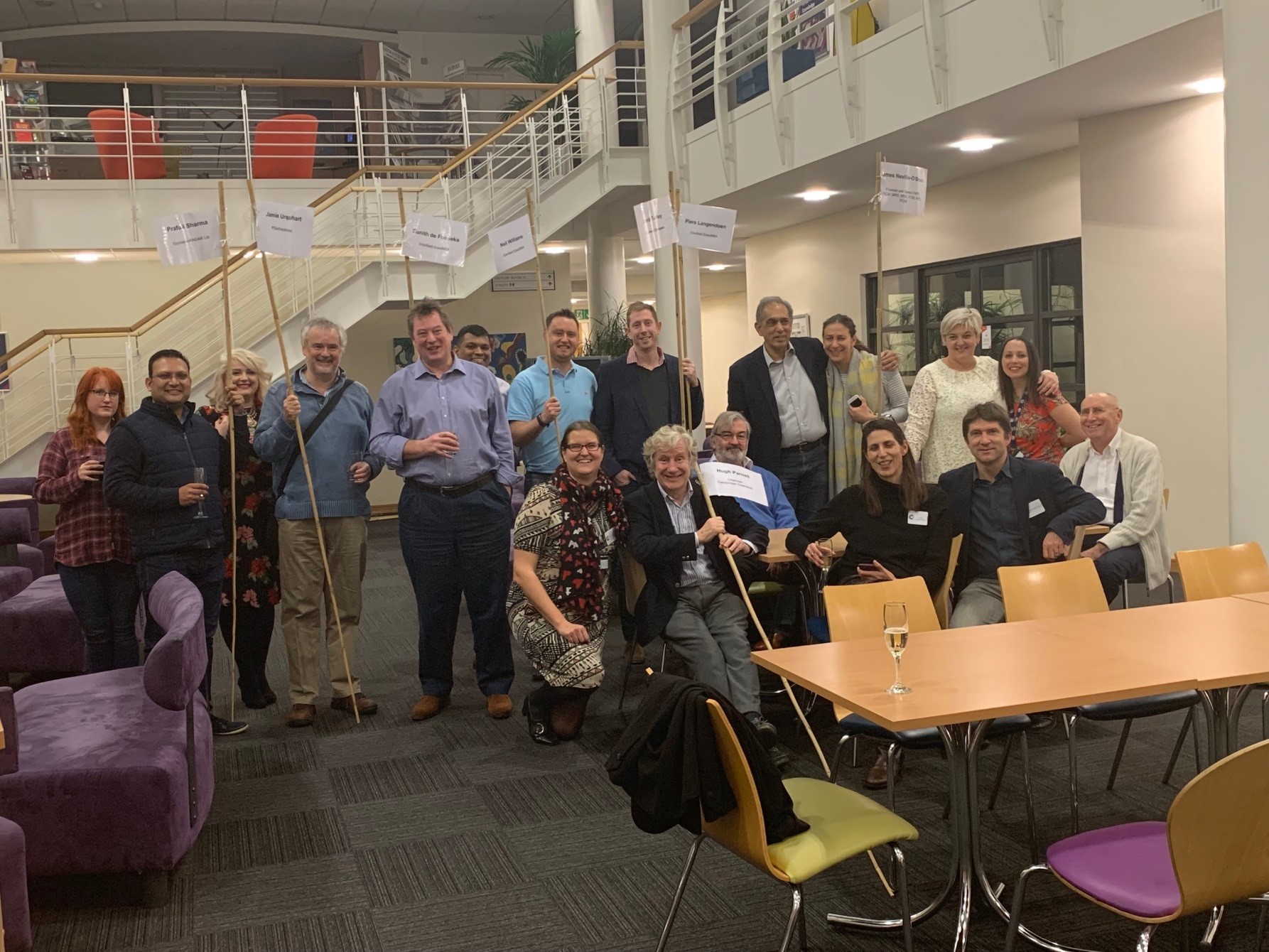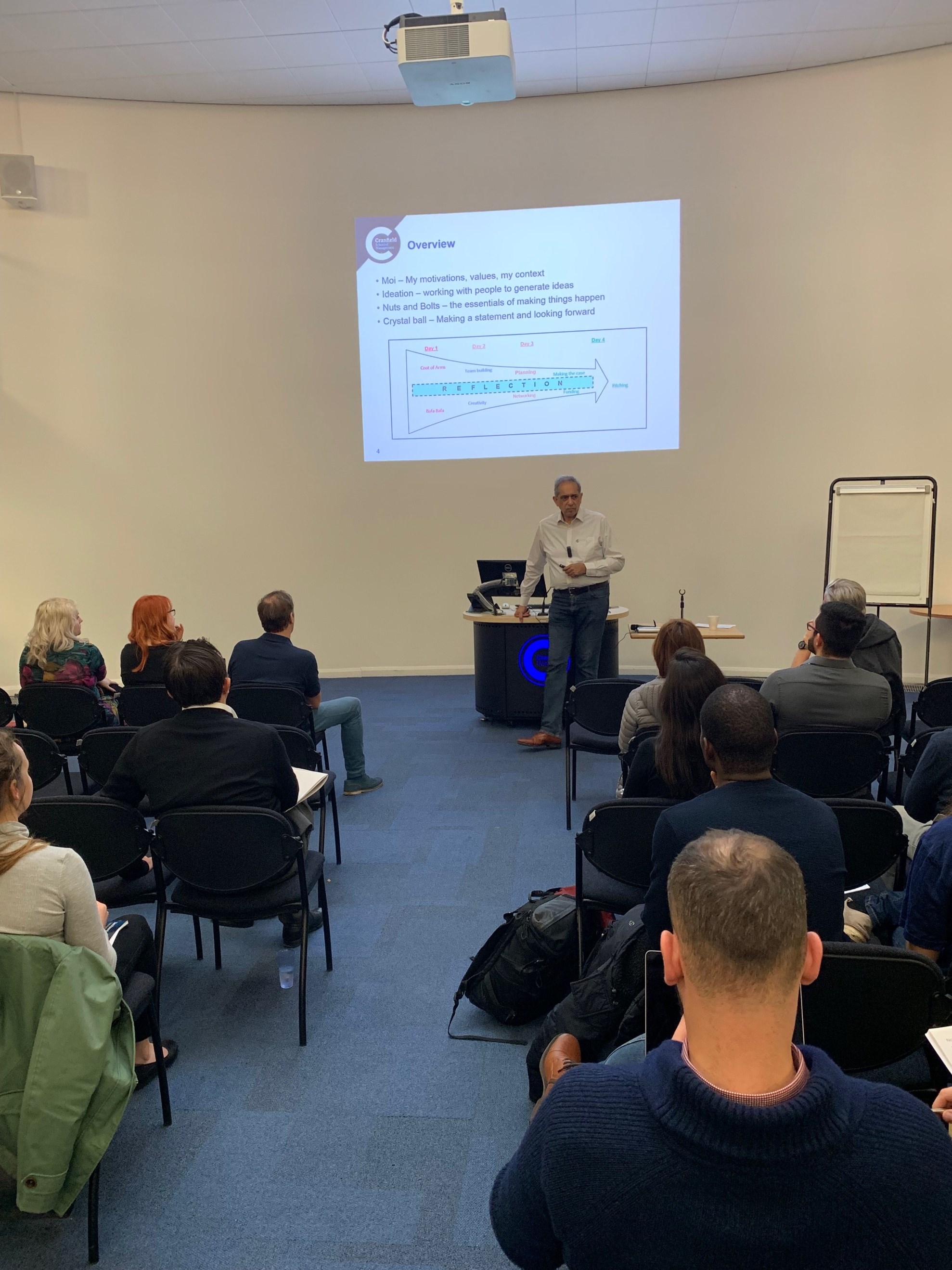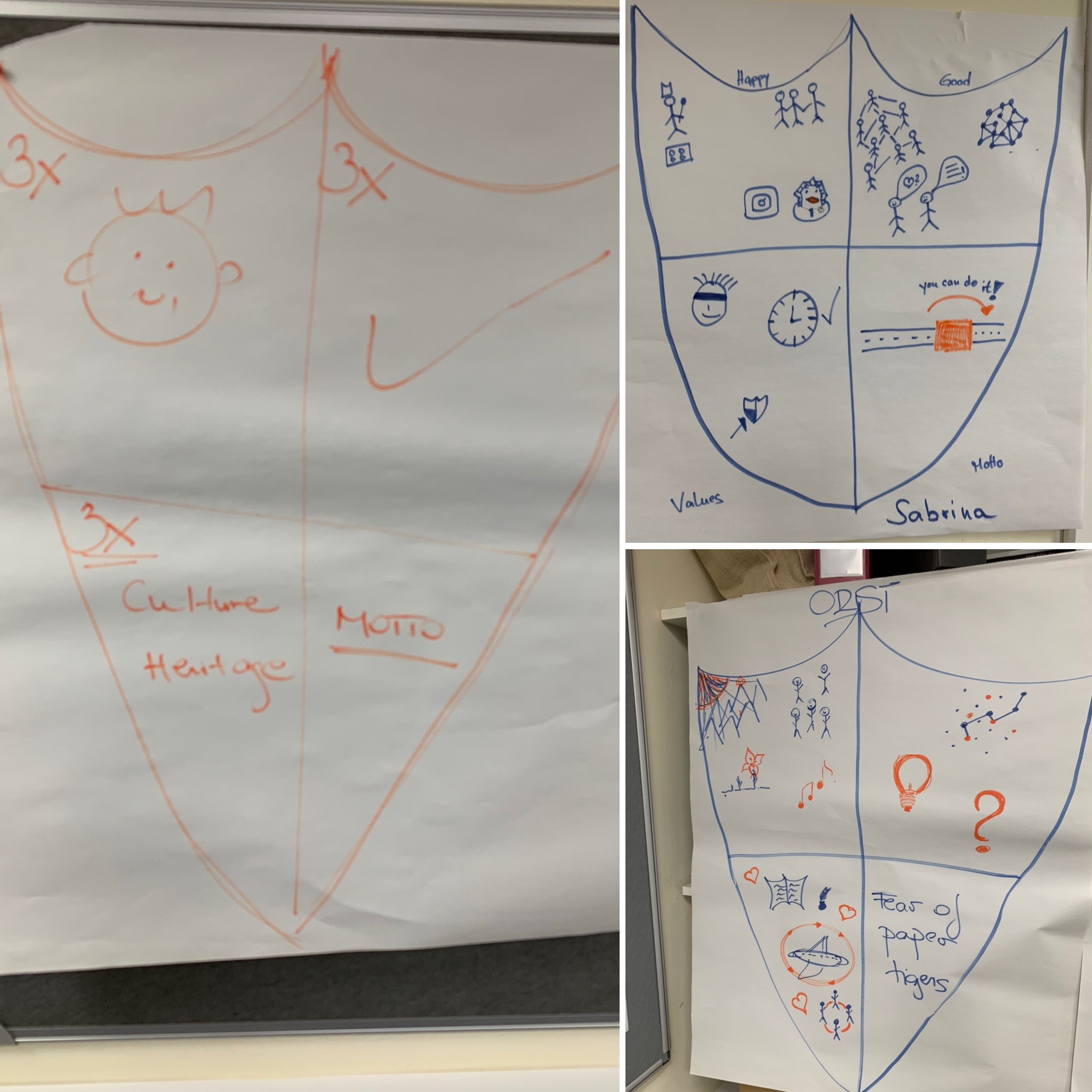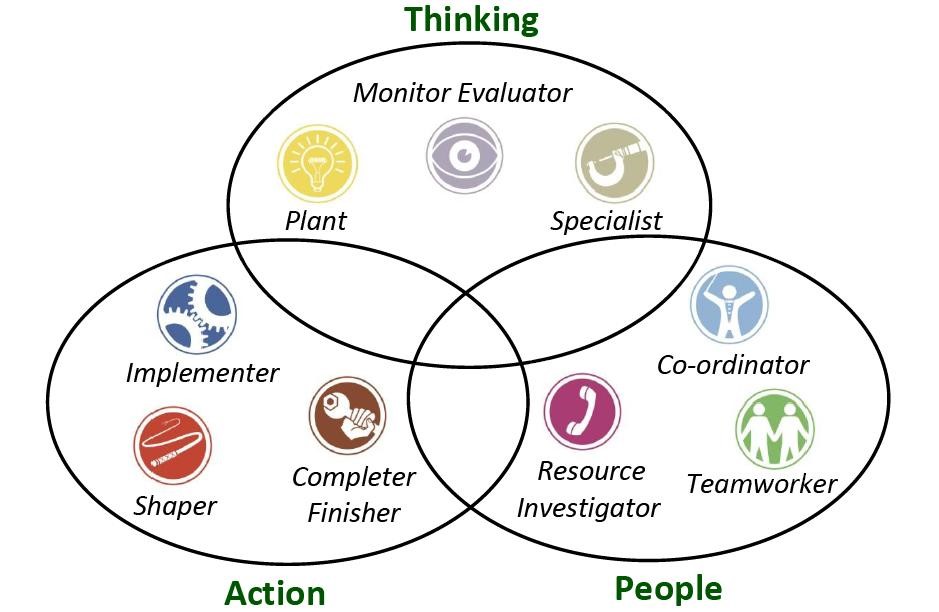The 40th Ideas to Innovation (i2i) workshop
04/02/2019

On the morning of Wednesday 5th December the CMRI Gallery quickly filled with 40 PhD and postdoctoral students to start a fascinating journey at the Ideas to Innovation (i2i) workshop. i2i was founded in 2002 this was the 40th time that it was run by the Bettany Centre for Entrepreneurship.
On the first day of the workshop, Dr. Shailendra Vyakarnam, Neal Hartman, Orsolya Ihasz and the facilitation team welcomed researchers and scientists to unlock their entrepreneurial and creative potential. The four-day workshop is practical and based on experiential learning which enables participants to clarify and sharpen the purpose statement and the intent for their research. In the beginning participants are focussed on the details of their individual research, by the end of the programme they are able to see their ideas through the eyes of the other participants, allowing them to articulate the impact and benefits of their ideas and products.

After the scene setting part of the morning, we split up into five groups to start the first hands-on part of the day.
Getting started
Instead of diving into the deep technical details of each other’s research areas, we worked on unlocking creativity by drawing a “Coat of Arms”, explaining in pictures what makes us happy, what we are good at, our cultural heritage and our personal motto. It is always amazing to see how clear the thinking becomes, when using pictures and not words. With lots of laughter and sharing our personal values and motivators, we were already deep into the team building for the week. By connecting on a different level than a usual introduction, the teams were quickly building trust and understanding, realising that most of the young researchers wanted to have a positive impact on the world we live in.

What is the social or economic relevance of your research?
The next exercise was to get a better understanding of the research areas and a first definition of the topic. One such example was: “My research is in Quantum Physics (I understand so much as it involves a dead-or-alive cat of Mr. Schroedinger) related to Atomic Force Microscopes (in the single digit (ok, I get that) nano-meter spectrum (that is pretty small I think) to {insert word I did not understand or could spell} by doing {insert another word I have never heard in my life}”!!
What was more important than us really understanding the research was the start of a process to help our group to understand the impact and the value of their research, by asking questions and guiding them to start seeing their idea more clearly from an outsider’s perspective.
After a guided reflection exercise and dinner, we engaged the participants in a cross-culture simulation to allow them to understand the importance of communication, values and collaboration. The group was split into two groups and each was allocated a different culture. By sending visitors to each other to explore the other culture, the teams learned about the difficulties this experience can have. An important question which was discussed was: “Who is responsible for adapting to the other culture. The visitor, the host or both?” This activity helped the participants who are often so focussed in the details of their own work to understand how to learn to communicate with others.
The importance of team work
The next morning continued with team building and introducing the Belbin Team Roles. A very effective way to demonstrate how a team becomes more efficient and successful by leveraging each other’s strengths as well as realising the importance of the help of others on your journey.

Part of this exercise was to bring 5 out of 10 unusual items back to the room, including a purple shoe or a boiled egg. While one group decided to send a student living on campus home to boil an egg or to buy a Scotch egg at Budgens, some teams were more creative than others. A big thank you goes to the two ladies who lent one of their purple shoes which they were wearing on the day to two of the teams.
The coordinators in the group then demonstrated their ability to herd sheep, by coming up with a strategy of how to communicate with their blindfolded team just by using a whistle. It was funny to watch and see the different approaches the coordinators took in how to communicate with the individual (how do you identify the whistle sounds are for you) and how to use the command to move a blind folded person in the room. Needless to say, all teams did very well and mastered this challenge without a problem.
All groups again were one step further on in their journey to understanding themselves and their part within a team.
Unlock your creativity
By now the teams were way more comfortable with each other and with doing things they were not doing on a day to day basis. It was time for the Creativity Café.
Using the iterative approach, also known from agile development that you have a limited amount of time to complete the task. In the next iteration you then are able to build upon the results of the previous round. This allows a variety of ideas to come up in this process.
After three rounds of divergent thinking, a last round of “cleansing” and convergent thinking is applied to the ideas. This allows to creation of themes, the rejection of some ideas as not applicable right now and to give a rounded but focused understanding of the idea.
The outcome of that activity was then enhanced by the input about market needs, customer value prepositions and how to fund your idea in the first year on the following day.
The groups now had all the tools to health-check and specify the needed activities. It was interesting when the group suddenly realised that you could only earn £20 an hour for selling a small item and at the same time you need your own man power to improve the prototype. That was a defining moment to realise you need help and can’t do it all alone and that implementing a business idea is not just about the research and there is so much more to it.
Networking and the “real entrepreneurs”
After practising our pitching and networking skills, the scariest part of the week slowly started. Meeting the real entrepreneurs and realising that you CAN do it. We met three Cranfield Alumni all at different stages of their entrepreneurial success; people who made the step our participants were about to make.
- Glenn Collinson , co-founder of CSR Cambridge Silicon Radio
- Prafull Sharma, Inventor and Co-founder of Corrosion Radar
- Nancy Roberts, Founder and CEO of Umbrella Analytics

The three entrepreneurs explained the opportunities, risks and explained how they had to step out of the comfort zone they had to wrestle with. It was a great start for the aspiring followers to engage in conversation. In the evening, everyone had the opportunity to practice their networking skills with more fascinating successful entrepreneurs and people from industry.
How transformation looks
Saturday morning was now all about pitching the ideas our participants have worked on for so long and implementing the new tools and understandings they had learnt the last three days. How would this be different to Wednesday morning?
Ten teams presented their three minute pitch to the group and a panel of three facilitators, creating the feeling of a real pitch with critical questions but also allowing some feedback on what was good and what could be further improved. When you could see the sparkle in some speakers’ eyes or hear the confidence in their voice when explaining their work in an attention grabbing way, you were able to see the amazing difference the hard work over the four days had made.
After a farewell celebration, the participants went back to their day-to-day lives, filled with energy, encouragement, new tools and a clear focus of the next steps of their journey. We look forward to seeing them again, maybe as part of a future entrepreneur panel sharing the insights of their journey.
Categories & Tags:
Leave a comment on this post:
You might also like…
From nature walks to neural networks: My journey in Applied AI at Cranfield
Hi, I’m Ebru K and choosing a postgraduate degree is about more than just picking a subject; it’s about choosing where your future begins. As an international student from Turkey, I ...
Leading With Heart: My Journey as Cranfield Student Association President by Summer Yan
When I first arrived at Cranfield, I had no idea that one year later I would be standing at the heart of our student community, serving as President of the Cranfield Student Association (CSA). ...
Creating and using constituent lists in Datastream
Whether you're analysing industry performance, or comparing company financials, Datastream is a powerful tool. One of its most useful features is the ability to work with constituent lists — collections of companies grouped by index, ...
Landing at Cranfield: First-term experiences and life beyond the classroom
Starting a postgraduate course can feel daunting, especially if you’re new to the aviation industry. In this blog series, Adit Shah shares his journey on the Air Transport Management MSc at Cranfield. From first-term ...
Accelerating ambition: How Amelie Rohan engineered her future at Cranfield
In the world of high-performance automotive engineering, the gap between being a “fan” and being a professional is measured in more than just miles. It is measured in technical precision, hands-on ...
Study better and smarter in 2026
Happy new year! Now is the perfect time to reflect on your studies so far, thinking about what you’re doing well and where you need to focus a bit more attention. Getting back into ‘study ...






